Looking at a Windows tooltips class hint window, i see that it draws its drop-shadow outside the hint window's actual rectangle.
Using SpyXX - i can get the tooltip's window rect, and class styles:

Rectangle: (440, 229)-(544, 249), 104x20
Restored Rect: (440, 229)-(544, 249), 104x20
Client Rect: (0, 0)-(104, 20), 104x20
You'll notice that the drop shadow you see is physically outside the window that's being drawn. How can i draw a shadow outside around my window, while being outside my window?
Note: The shadow is not drawn using the standard CS_DROPSHADOW class style. i've confirmed this experimentally, and can also see the class style's for the window in SpyXX; it does not use CS_DROPSHADOW:
Windows Styles: 94000001
WS_POPUP 80000000
WS_VISIBLE 10000000
WS_CLIPSIBLINGS 4000000
TTS_ALWAYSTIP 1
Extended Styles: 00080088
WS_EX_LAYERED 80000
WS_EX_TOOLWIN 80
WS_EX_TOPMOST 8
So how can i draw outside my window?
Note: Trying to draw on the desktop DC is out. From Greg Schechter's Redirecting GDI, DirectX, and WPF applications:
Drawing To and Reading From the Screen -- Baaaad!
Lastly, since we're on the redirection topic, one particularly dangerous practice is writing to the screen, either through the use of GetDC(NULL) and writing to that, or attempting to do XOR rubber-band lines, etc. There are two big reasons that writing to the screen is bad:
It's expensive... writing to the screen itself isn't expensive, but it is almost always accompanied by reading from the screen because one typically does read-modify-write operations like XOR when writing to the screen. Reading from the video memory surface is very expensive, requires synchronization with the DWM, and stalls the entire GPU pipe, as well as the DWM application pipe.
It's unpredictable... if you somehow manage to get to the actual primary and write to it, there can be no predictability as to how long what you wrote to the primary will remain on screen. Since the UCE doesn't know about it, it may get cleared in the next frame refresh, or it may persist for a very long time, depending on what else needs to be updated on the screen. (We really don't allow direct writing to the primary anyhow, for that very reason... if you try to access the DirectDraw primary, for instance, the DWM will turn off until the accessing application exits)